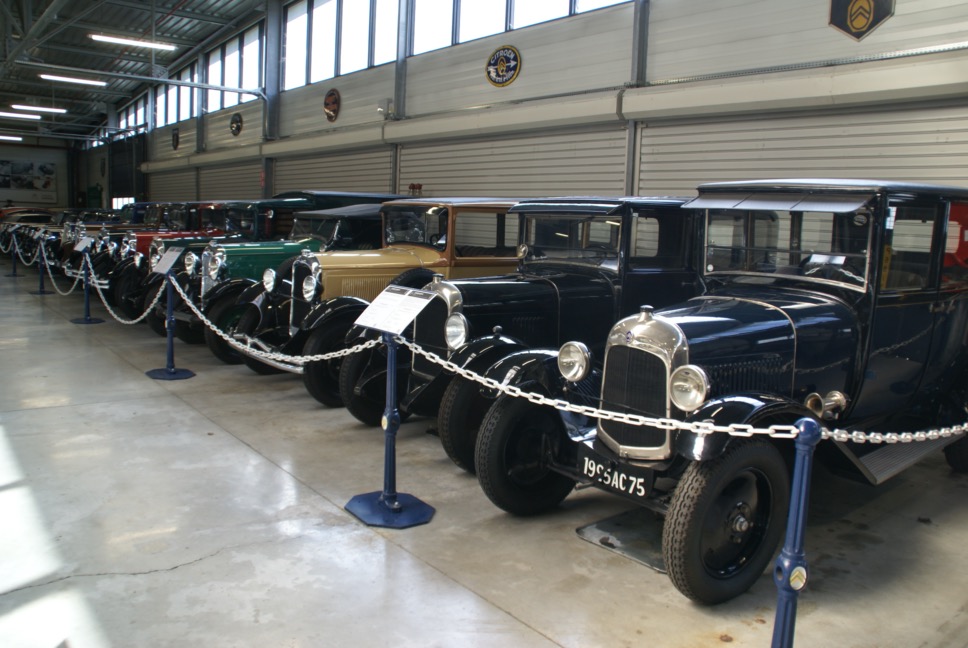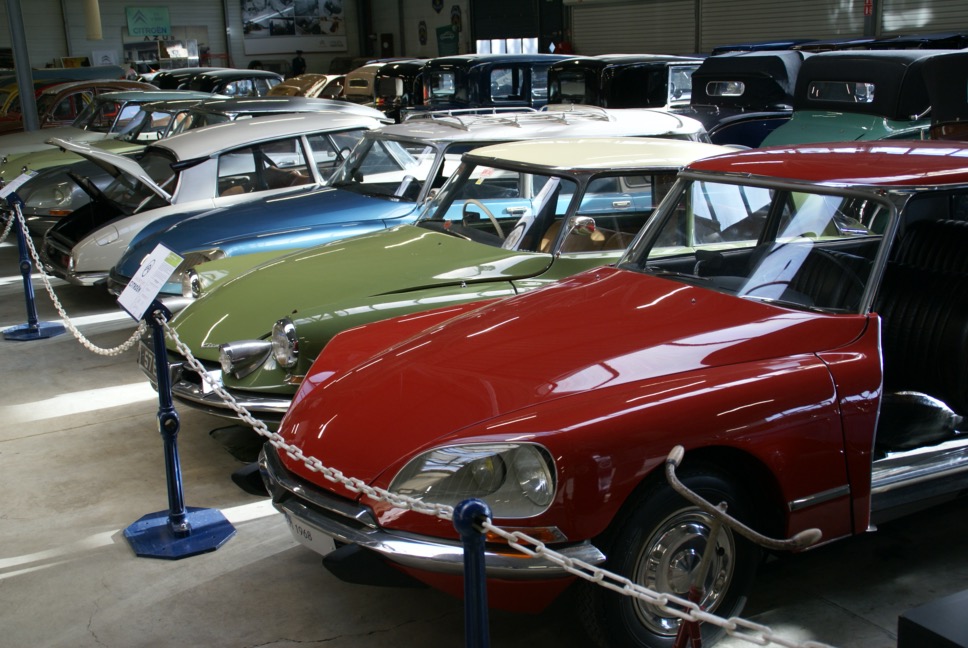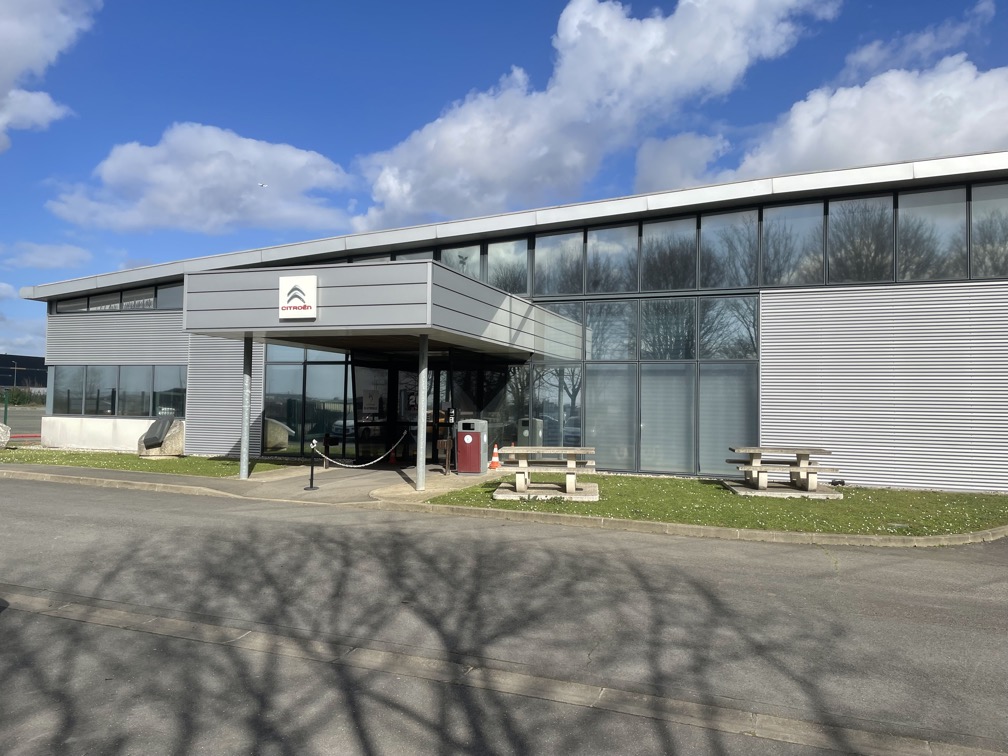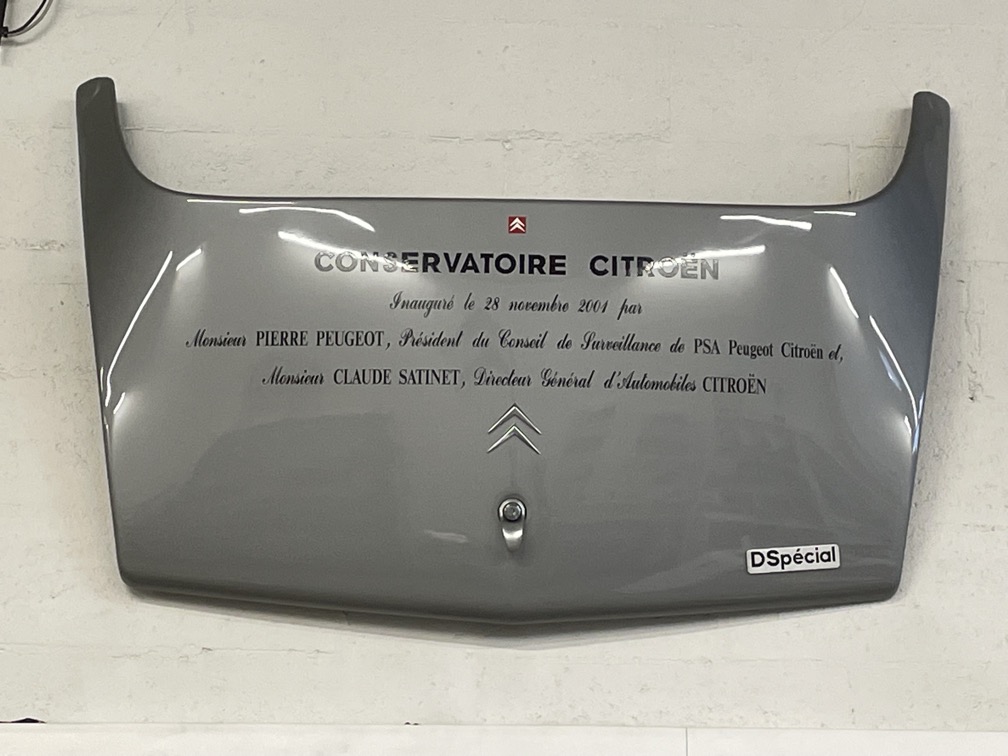



Citroen et DS Conservatory History
As early as the 1960s, Citroën began collecting cars, either kept by the factory, bought or as a result of donations. The cars have been restored when necessary and stored in various locations, pending the creation of a museum. Finally, the Citroën Conservatory was inaugurated in 2001, with the mission of preserving the memory of the brand and being able to present it to the public. The already significant collection has since been enriched, including concept cars and many racing cars. The name Conservatory, rather than museum, illustrates the objective, with the exhibition of a very large part of the models built by the brand, from the origins in the 1910s to more recent productions. Moreover, the Conservatory now receives at least one copy of each model produced, even if the current models are not exhibited to continue to maintain this memory. Since DS Automobiles has become a brand in its own, the Conservatory also has a very large number of competition cars and concept cars, which is rather rare for a museum. The Conservatory is located in Aulnay-sous-Bois, where a factory of the group was located, in a building built for this purpose. The place is vast (6000 m²), but the decoration is limited and the setting more industrial than museum. However, the advantage of this location is the richness of the exhibition, with nearly 300 vehicles. There is talk of creating a museum one day, which will no doubt allow a more flattering presentation of the collection, but then there will probably be far fewer cars on display. The visit is therefore recommended as long as you can discover so many models!
My Favorites
With nearly 300 vehicles, the Citroën and DS Conservatory presents production cars as well as prototypes, concepts and racing cars. Not to be missed (but it remains subjective) in this first part:
- The Type A, beginning of the Citroën adventure and mass production in France
- The green C4G roadster of the 1930s, gleaming and desirable
- The SM which remains one of the icons of French production
Citroën et DS Conservatory
The collection exhibited at the Citroën and DS Conservatory being rich, important and varied, the visit article is published in 2 parts. This first part covers the beginnings of the company with Type A, B and C, the Traction which makes the link with the post-war, then the 2 CV (and its derivatives), DS and SM. In the 2nd part published next month, I will cover the more recent models, racing and concept cars. Due to its location, the Conservatory has a huge free car park. You enter a lobby with a shop that offers a large selection of books on the history of the brand and its models, and objects: models, miniatures, textiles, photos and posters ... A space in the lobby welcomes each year the models of the brand that celebrate an anniversary in the year. For 2023, the Xantia, which celebrates its 30th anniversary, is in the spotlight. Photos, logos and posters decorate the walls, and a DS rear cover, hanging above the entrance to the exhibition hall, recalls the inauguration of the Conservatory. In the large exhibition hall, the cars are displayed in broad outlines, grilles towards the visitor, on a regular plan following the chronological order. Around this plan, there are 2 large thematic islands dedicated to competition and concept cars, and several smaller spaces, also themed, such as the ancestors of the 2 CV or presidential cars. The Conservatory also has a large workshop for the restoration and maintenance of vehicles. In addition, it keeps a very large amount of archives of the brand, photos, plans, documents...

Industrial beginnings
Upon entering the hall, the Type A, Citroën’s first model, is presented separately. In 1919, the Type A is the 1st European car built in large production, the 1st also delivered complete and bodied (previously, manufacturers delivered chassis to coachbuilders), the only solution to lower costs and attract a wider clientele. The Type A is economical, but it is equipped with a starter, electric lighting and a spare wheel, as it is also necessary to make life easier for the motorist. With the Type A, the Automobiles CITROEN brand was born with the “Double Chevron” as its emblem. After the Type A comes in 1921 the Type B2, part of the range of which is presented opposite the Type A.




From the same chassis (on display), Citroën offers several bodies to meet different needs: robust 2-seater coupe, nicknamed doctor coupe because it is widely used by doctors (it is one of the first acquisitions of the collection), more luxurious landaulet with closed cockpit for passengers, 2-seater convertible or 4-seater torpedo, Caddy for the small “sporty” 2-seater torpedo (very popular with famous actress Mistinguett) and the Normande, family and utilitarian. The B2 will even be modified in half-track version at the request of Georges-Marie HAARDT for the 1st crossing of the Sahara by car in 1922.





Also in 1921, Citroën presented the 5 HP or Type C, equipped with a smaller engine and which was intended to be a popular car. It is characterized by its pointed back, and presented in a bright yellow color, it will be nicknamed “Lemon”. Citroën also offers a 3-seater torpedo, and the layout of the seats will earn it the name Trèfle, which becomes the nickname of all Type C. New revolution in 1924 with the Citroën Type B10, the first European car to adopt an “all-steel” body, replacing the wooden frame covered with sheet metal. Based on a B2 chassis, this model will make the transition with the new Type B12. This was followed by the Type B14, which in its various versions exceeded the figure of 100,000 units produced between 1926 and 1928. The cars on display show the variety of bodies of the 1920s, coupe, torpedo, convertible … while each model brings new equipment, maintaining Citroën’s image of innovation.
In 1928, the Type C4 succeeded the Type B. At the same time, Citroën presents the C6, equipped with a 2.4L in-line 6-cylinder engine, which testifies to the manufacturer’s move upmarket to meet the expansion of the customer base. Note that the models are almost identical up to the level of the cabin, and that it is then that the body is distinguished according to the type of model targeted. Two-tone paint, paint nets, chrome, the C6 is luxurious by several exterior details. Moreover, the C6 presented at the Conservatory belonged to the famous Sacha Guitry. The C6 will be quickly modified with a wider body, becoming C6 E (for Enlarged) to stand out from the C4.






Among the models on display, the C4G Roadster is particularly attractive: luxurious finish, radiators with thermostatic shutters, metal green paint, body-colored painted rims. Note the small side hatch, which opens onto a small trunk intended to accommodate golf equipment, an undeniable touch of luxury in 1932! The roadster is obviously much rarer, since barely 10,000 will be sold, out of a total of nearly 250,000 models produced. Like the B2, the C4 will also be transformed into a half-track (labeled P17), this time for the Yellow Cruise, expedition between Paris and Beijing in 1931-1932.




In 1932, Citroën completely renewed its range, and the Type 8, 10 (4-cylinder replacing the C4) and 15 (6-cylinder replacing the C6) quickly took the name Rosalie. This is the name of a special Type 15 model that will break an endurance and speed record, 136,083 kilometers, at an average of 104 km/h. In 1933, the Petite Rosalie, derived from the Type 8, covered 300,000 km without stopping (other than refueling) at an average speed of 93 km/h, beating a total of 106 world speed and endurance records!
And Rosalie becomes the name of the whole range. As with previous models, the chassis serves as the basis for several bodies, from the coach to the limousine. But Citroën also delivers chassis to external coachbuilders, which makes it possible to multiply the offer with convertibles, fake convertibles, coaches, 2 seats, 4 seats, spider… Thus, with 5 chassis, Citroën offers more than 50 models in its 1933 range. Obviously impossible to present them all, and the Conservatoire exhibits several models 8, 10 and 15 in sedan, limousine or convertible models.



Note the swan that appears on the radiator or even in radiator cap on the Type 15 limousine: it symbolizes the presence of the new generation of “floating” engines. The Rosalie will be the last Citroën with rear-wheel drive, since in 1934 appears the Traction. The arrival of the Traction will lead to a redesign of the Rosalie range in 1935, the Rosalie 7UA and 11UA being now equipped with the engines of the Traction for the purpose of rationalization.



The Traction
The introduction of the Traction marks a new revolution for Citroën. Contrary to what is often thought, Citroën did not “invent” front-wheel drive, nor is the first manufacturer to offer front-wheel drive. But Citroën is the 1st major manufacturer to do so, and especially its engineers have perfected and made this solution reliable for use in mass-produced cars, for a wide audience. The car is not called Traction at the start, but 7A, then 7B, but will be quickly named so by the public and is known worldwide under this name.
The Traction also innovates by its monocoque structure, an aerodynamic line very different from contemporary productions, the work of stylist Flaminio Bertoni. Thus, the Traction is immediately recognizable, and remains so today. Citroën is developing a range around this concept, with different engines ranging from 1.3L to almost 3L, and several bodies: sedan, wagon, limousine, van, coupe, convertible … Its various innovations give the Traction excellent handling compared to its competitors, and it will stand out in racing, but will also become the favorite car of gangsters. The Conservatory exhibits several models 7 and 11 and it can be seen that the aesthetic evolutions were minor despite the long career of the Traction.




Presented in 1939, the Traction 15-6 is equipped with an in-line 6-cylinder and crowns the range. Powerful and fast, it was nicknamed the “Queen of the Road”. It was produced in just over 40,000 copies. Production of the Traction continued after the war, until 1957. In 1957, Citroën innovated again with the 15-6 H, which was equipped with hydraulic suspension at the rear. The model presented at the Conservatoire is a test model that was used to develop the suspension of the DS. The Traction also existed as a coupe, curiously called “fake-convertible”, perhaps because of its 2 exterior seats. Traction “real” convertible, sometimes also called roadsters, are very rare, with only a little more than 500 units produced, of which only 5 in 6-cylinder version.One of the models presented has the particularity of having been modernized by its owner over the years.





In 1933, Citroën had launched the project of a Traction 22 V8, with an engine reusing many parts of the 4-cylinder Traction 11. The engine did not deliver the expected results (Citroën wanted a power of 100hp), the project will be abandoned, and the few prototypes will be destroyed. From time to time, the myth resurfaces, but each time it is replicas or other models. So, unfortunately, no 22 V8 is on display at the Conservatory…
The 2 CV and its derivatives
The 2CV is another Citroën revolution. Again, an original, innovative and recognizable car. Presented in 1948 and produced from July 1949, the 2 CV had a very long gestation since the first studies had begun in 1937. In 1939, the car was ready to be presented, it was homologated, but the war arrived, and Citroën destroyed the 250 models already manufactured so that they did not fall into enemy hands. Only 3 prototypes survived, hidden in an attic of the Citroën test center in La Ferté-Vidame. They are exposed in a corner of the building, just before approaching the island of 2 CV … If we recognize the general line of the 2 CV, the final design will have matured.




The 2 CV takes its name from its fiscal power (a French specialty related to engine size) and keeps it even when equipped with a larger engine. The Conservatoire exhibits about fifteen models, which shows that stylistic changes have been very limited despite a career of 42 years: front hood, grille, headlights, opening of the doors (but it does not change the shape), rear hood (instead of the original tarpaulin),3rd side window… We find the Spot (1976) orange and white and the Charleston with its two-tone black and burgundy paint, which gives it a chic style, and which will be a great success.
Less chic, the 2 CV van followed technical and stylistic evolutions of the 2 CV, satisfying many professionals. It has also become a model of choice for explorers with its higher cargo volume. The 2 CV 4×4 Sahara has an original architecture since it receives 2 engines, one at the front and one at the rear, to ensure the 4-wheel drive. Designed for oil exploration, it is an outstanding franchisor in the sand. It will know a limited success, with less than 700 units, but is now very sought after.





The 2 CV has been manufactured in several foreign Citroën factories, in Portugal and South America, but also in England in a slightly modified version, including rear windows that open from the middle like the front windows. The car on display, 3rd produced by the factory, is the oldest known. The 007 on display is not one of the special series, but one of the James Bond shooting models “For Your Eyes Only”, mechanically modified and reinforced, and also a little dented! The 2 CV 6 By Hermes is also unique, a car from 1989, but dressed inside and outside by the luxury house in 2008 to celebrate the 60th anniversary of the 2 CV. It is also a reminder that this car has been found everywhere and in all social strata. The 2 CV is currently the most collected car in the world!



The Dyane, presented in 1967, is a close cousin of the 2 CV. Slightly more powerful, with a line that is more modern with its headlights integrated into the front wings, the Dyane is positioned slightly above the 2 CV without competing with the AMI 8. It is also equipped with a rear hatchback to compete with Renault’s rival 4L.
Let’s take a step aside in the chronology to evoke the models derived from the 2 CV. In the early 1960s, Citroën offered 2 very opposite ranges, with the rustic and popular 2 CV, and at the other end the high-end and luxury with the DS. The idea has come to fill this gap, and to do it economically, the AMI 6 is developed on the mechanical basis of the 2 CV, chassis, suspensions, brakes, engine… Its main originality is its inverted rear window that is found at the same time on English Anglia. Then comes the AMI 8, with the more conventional line. The last of the line will be the AMI Super, still on the same basis but modified to receive the GS flat 4-cylinder engine.
At the end of the 1960s, fashion was leisure, the Buggy were all the rage in California, and Citroën presented the Mehari in 1968. Still on a 2 CV base (or Dyane to be accurate), but with a thermoformed and tinted ABS plastic body, folding plastic soft top for the sides and roof. If the Mehari is seen primarily as a leisure car, it will also be used by many professionals. The Mehari will be produced in nearly 150,000 units in 20 years. A little more than a thousand will be in 4WD, and the Conservatory presents one of the cars used in medical assistance on the Paris Dakar 1980. The Mehari 4×4 is particularly recognizable by its spare wheel on the front hood.




After a few years in oblivion, the Mehari has once again become a sought-after car. If ABS bodies have suffered from the passage of years, molds have been recovered and body parts have now been remanufactured. There is also a curious model, the C60 prototype developed in 1960 by Bertoni with the idea of expanding the range with a model that would have positioned itself between the AMI 6 still in preparation and the DS. The car is also a curious mix between these 2 models, and let’s say (subjective opinion) that we have seen Bertoni more inspired.
The DS
On October 6, 1955, the DS was presented at the Paris Motor Show. The success is considerable. Citroën is once again revolutionizing the automotive world, with a totally original aerodynamic line by Flaminio Bertoni, a true sculpture, but also by on-board technologies, including suspension, clutch, braking, and hydraulic power steering. The interior is also innovative, especially its dashboard that stands out from everything that was done at that time. Only the engine taken from the Traction is classic. The last DS rolled off the line on April 24, 1975, after almost 20 years of production and nearly 1.5 million units.
During this long career, the DS introduced several innovations, such as steerable headlights in 1968 or electronic fuel injection in 1969. The Conservatory exhibits a dozen models, sedans and station wagons DS 19, DS 21, DS 23, Pallas and Prestige finishes, as well as ID and DSuper, entry versions of the DS range … The top of the range is the DS 23 Pallas Electronic Injection, certainly the most prestigious and highest-performance French sedan of its time. The model presented is equipped with air conditioning, ultimate luxury at that time. The Cabriolet DS is of course present.



The”factory” DS Cabriolet will be produced for about ten years, between 1960 and 1971, at about 1300 units, by the coachbuilder Henri Chapron, alongside its own derivatives. Suffice to say that this beautiful car is rare and has become extremely expensive in collection, well exceeding € 200,000 for a model in good condition. A model of DS 21 Pallas, presented at the 1967 Paris Salon on the occasion of the redesign of the front part, was restored for display at the Conservatory. The absence of doors makes it possible to see the interior, a real rolling lounge and its atypical dashboard.




For the official launch of the DS Automobiles brand as a separate entity, a DS 21 from 1969 was restored and brought into conformity with the color and material of a modern DS 5, the color Ink Blue and leather comes from these DS 5. Another original model, an English DS, in a green color specific to England, and with a slightly different front, in particular the Citroën wording on the hood. The DS was also a formidable rally car, as we will see in the chapter on competition.



La SM
Without being as revolutionary as the DS in its time, the SM undoubtedly marked the spirits when it was launched in 1970, especially by its very aerodynamic line and once again quite original. It takes and perfects technical solutions already seen on the DS and adds as the steering whose recall is tied to speed. The cabin is that of a Grand Touring car, made for long and fast journeys, with a very futuristic dashboard, and a steering wheel adjustable in height and depth, a 1st in Europe. It also benefits from a noble and powerful mechanics with its Maserati V6 (owned by Citroën at that time), which ensures very good performance.




Flagship of French production, reviving a tradition lost for several decades, the SM will unfortunately be a victim of circumstances: oil shock, speed limits, takeover by Peugeot, maintenance problems of a complex car by a poorly formed network… Less than 13,000 cars will be produced in 6 years. After being abandoned, the SM finds the favor of amateurs and its rarity is now rapidly rising prices.
The Conservatory exhibited several, including 2 models used for press tests during the launch of the 2 versions, carburetor in 1970 and fuel injection in 1974. Next to the SM, an interesting style study born in 2010 from an unprecedented partnership between a team of Citroën designers and the British edition of GQ magazine. GQ by CITROEN presents itself as the ultimate men’s car. With a contemporary style, a sculpted front end, muscular sides and a rounded rear, GQ by CITROEN could have been an attractive proposal for a 21st century SM.



To be continued next month…
Youngtimers, competition and style studies…
The photos on this page belong to Automobile-Museums, no use or reproduction is authorized without the prior written consent of the owner.
Museums are living places, and therefore the content or layout may have changed between the publication of this article and your visit. The layout may be different, cars may be absent (overhaul, maintenance, loan…) and new ones may have joined the exhibition.
